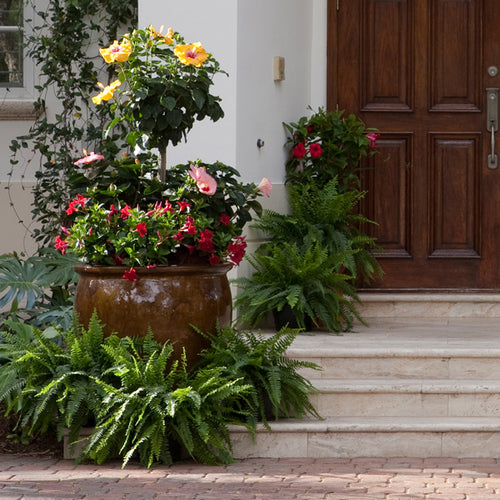
Copperleaf
The reddish-bronze variegated leaves of copperleaf make a great addition to pots, planters or the garden border. This heat-loving beauty, grows quickly and can survive in sun or partial shade--the brighter the light the more intense the leaf color. Copperleaf also plays well with colorful flowering annuals, especially those with red blooms such as zinnia, begonia, or geranium. Mature plants are drought tolerant, but younger specimens prefer rich, slightly moist soil. In the deep South, copperleaf will form a 3 to 5 foot tall shrub.
Persian Shield
Prized for its shiny purple and green foliage, Persian shield also sold under its genus name, Strobilanthes. It makes a bold "thriller" plant in mixed containers or looks amazing planted by itself in a decorative urn or pot. Persian shield will grow in sun or shade, but needs to be kept slightly moist if planted in an exposed location. If your plants start to get a bit leggy, pinch it back to encourage more compact growth. In frost-free regions, this plant will grow 3 to 4 feet tall.
Agave
Not all tropical plants are from the tropics. Some, like the agave, are native to desert locations where rainfall is scarce. Agaves vary in winter hardiness, but most won't tolerate below freezing temperatures and should be used as container plants in the North that can be brought indoors once the weather gets cold. But, in frost-free regions, agaves make colorful and dramatic landscape plants, especially for hot, sunny areas with low to moderate rainfall. Agaves come in different sizes, but most will eventually grow 3 to 4 feet tall and wide. Just be careful of the sharp points at the end of each leaf.
Shell Ginger
In the Deep South, shell ginger is treasured landscape plant that produces quantities of boldly patterned gold and green leaves. These plants can grow 4 to 6 feet tall and eventually produce stalks of creamy shell-like flowers. But, more and more Northern gardeners are discovering these easy and colorful plants because they thrive outdoors during the summer and can be brought indoors to be treated as a houseplant in the fall. Shell ginger grows in partial to full sun and likes a rich, slightly moist soil.
Elephant Ear
Few plant names are as descriptive or as accurate as Elephant Ear. After all, these tropical beauties have pachyderm-like foliage, that slowly flaps in the garden every time there’s a slight breeze. Elephant ears come in a host of colors and bi-colors that include dark purple, chartreuse, lime green, and near-black. These jumbo tropicals can grow 3 to 6 feet tall so you’ll need some big containers to house them. Or, enough space in your garden to accommodate their bulk. Elephant ear thrives in hot, humid conditions and prefers rich, slightly moist soil. In the North, elephant ear can be dug and stored over the winter. In frost-free zones, the plants are perennial in nature, forming a dense wall of handsome foliage.
Canna
Bright flowers are probably the first thing most people think of when cannas come to mind. But in reality, it’s probably their large, colorful leaves that make the most lasting impression. Canna foliage comes in a variety of colors including chartreuse, burgundy, dark green, and striped. Cannas are easy to grow, too. Just plant them in a warm, sunny spot with some improved soil and stand back! These beauties grow quickly, often getting 6 feet tall. Dwarf forms that grow just 3 feet tall are also quite popular and are best for container use. Cannas do produce orange, yellow, or red flowers throughout the summer, but it’s their leaves that keep the color show going right up until frost. In Northern climates, cannas can be dug and stored over the winter, but in frost-free regions these beauties will form dense thickets of color.
Ti Plant
Often called the Hawaiian good luck plant, Ti plants offer lance-shaped purple foliage attractively striped with streaks of pink, cream, or white. In the North, Ti plant is frequently grown as a houseplant, but it works just as well outdoors in pots and planters, giving any setting a jolt of bold color. In frost-free regions Ti plant adds year-round landscape color, often growing 4 to 5 feet tall. Ti plant thrives in sun or shade, but the more light the plant receives, the more intense the color.
















